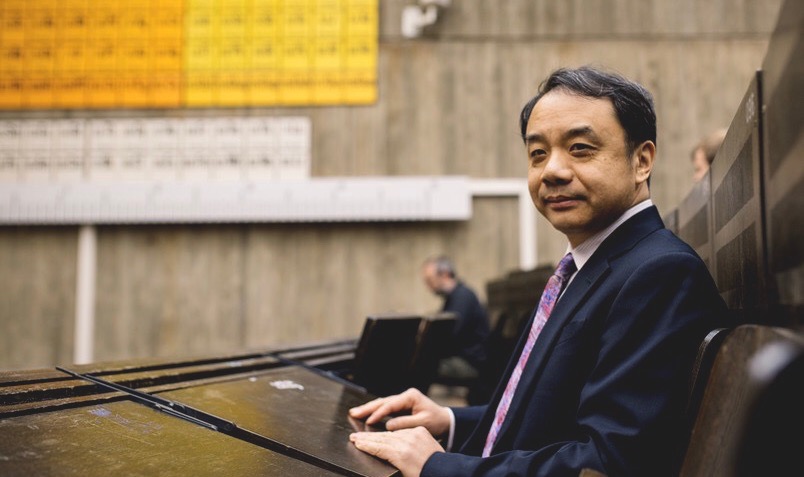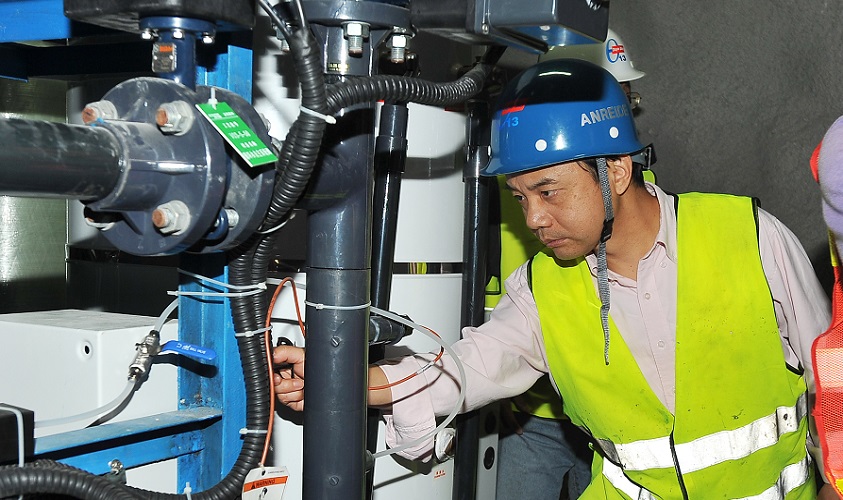Asia’s Scientific Trailblazers: Wang Yifang
Professor Wang Yifang shares about his fascination with neutrinos and elaborates on China’s ambition to become a major international center for particle physics research.

Wang Yifang Director Institute of High Energy Physics Chinese Academy of Sciences Beijing, China
AsianScientist (Sep. 15, 2017) - Given his significant contributions to particle physics research, it may come as a surprise to readers that Professor Wang Yifang started out as a reluctant physics student at Nanjing University. During the early 1980s, particle physics was a narrow and nascent field in China, and Wang knew he was entering unchartered waters. He dived right in nonetheless, and has since gone on to make his mark as a pioneer of particle physics research in China. He is recognized internationally as a heavyweight in the domain of neutrino physics.
After obtaining his PhD at the University of Florence in 1991, Wang spent a decade conducting research at MIT and Stanford University in the US before returning to China as a Professor at the Institute of High Energy Physics (IHEP) in 2001. He proposed the Daya Bay experiment to study neutrino oscillations in 2003, which eventually resulted in the first conclusive measurement of the mixing angle θ13 in 2012.
In 2016, Wang was awarded the prestigious Bruno Pontecorvo Prize and the Breakthrough Prize for his groundbreaking experiments at Daya Bay. His other awards include the 2015 Nikkei Asia Prize, the 2014 Panofsky Prize and the 2013 Science and Technology Progress Award, just to name a few. Read on to find out more about his award winning work!
Why did you decide to work on particle physics?
It was not really a conscious decision for me to work on particle physics. In fact, when I began my university education, there was no mature field of particle physics research to speak of in China, and I actually hesitated to take the course. But among all the different academic modules in university, nuclear and particle physics-at the very fundamental level-was interesting to me. Then after I obtained by bachelor’s degree in physics, I was selected from among many candidates to join Professor Samuel Ting at CERN to participate in the L3 experiment which involved the Large Electron-Positron Collider. And so began my journey in particle physics.
What are neutrinos and why was the Daya Bay experiment important?
Neutrinos are one of the elementary particles that make up the universe. They are the least well studied among the other subatomic particles in physics, and they have very strange properties. One such property is neutrino oscillation, which, put simply, is the spontaneous change in neutrino flavor as it propagates through space.
So, the motivation for the Daya Bay experiment was to learn more about neutrino oscillation. When neutrino oscillation was observed in 1998 and 2002, the whole particle physics community became interested in discovering the last unknown neutrino oscillation amplitude, what we call the mixing angle θ13, which has been assumed to be zero or very small.
Then in 2011, months before we began collecting data at Daya Bay, there were a few reports indicating that sin22θ13 is not zero. However, these were just indications—statistically speaking, they were not firmly conclusive. The results were at a level of less than 3σ, which means the signals being recorded could just be statistical fluctuations; there was still a few percent possibility of sin22θ13 being zero. It was the Daya Bay experiment in 2012 that first provided a firm conclusion, at a level of 5.2σ, that sin22θ13 is not zero.
There were many factors which, in the end, determined the success of the Daya Bay experiment. First, we needed very high-power reactors, so the Daya Bay nuclear power plant was ideal for that purpose. We also needed to build an underground laboratory that was shielded from cosmic ray backgrounds. Luckily, nearby Daya Bay there are mountains, and they provided the necessary shielding. Finally, we needed to design our experiment to keep uncertainties and experimental errors to a minimum. In the end, we were able to come up with a design that fully leveraged the advantages of the experimental location, thus producing a clear result.

Professor Wang Yifang at a ceremony to receive an honorary doctorate from Ruhr-Universität Bochum, Germany. Credit: Ruhr-Universität Bochum.
Can you tell us more about the Jiangmen Underground Neutrino Observatory (JUNO)?
JUNO is a continuation of our efforts from Daya Bay to study neutrino physics. Technologically, we are still using reactors and liquid scintillators, but on a larger scale.
From a scientific point of view, however, we are attempting to do something different with JUNO. Because the mixing angle has already been measured, we now want to measure the next mixing parameter known as the mass hierarchy; that is, we want to determine which is heavier—the type 3 neutrino or the type 2 neutrino.
In fact, JUNO will measure almost all the neutrino mixing parameters with very high precision, improving the precision of earlier measurements by almost a factor of 10.
In addition to what I’ve mentioned, JUNO can record data from astrophysical phenomena such as supernovae and solar neutrinos, so it is really a multipurpose detector which can do a lot of physics. It is the culmination of our existing knowledge and experience with detector construction, and we intend to build on that solid foundation to reach for higher science goals.
Do recent discoveries and new pursuits fit into or challenge the standard model of physics?
The standard model works extremely well, much better than people anticipated, say, 20 or 30 years ago. However, the success of the standard model has posed some problems for the particle physics community; foremost among them, it has left us with a very narrow window into the future—some physicists don’t know which direction to head towards in their research.
On the other hand, we clearly know that the standard model is not the theory of everything. There is definitely something more to be discovered; we just don’t know where to take the next step. This is a challenge to the whole community.
Some people believe that there is one direction towards the future, which is the detailed study of the Higgs particle—the last particle of the standard model to be discovered. There are many uncertainties and unknowns surrounding the Higgs particle and it is very much related to the so-called ‘defects’ of the standard model. It is also my personal belief that the Higgs is the next frontier of particle physics.
In the world, there are three proposals or ideas to study the Higgs in greater detail. The first is the International Linear Collider, and Japan would like to host this machine. The second is at CERN where they may build a circular e+/- collider, although this idea is not very favored. Most people at CERN would prefer to build a very high-energy proton-proton collider instead. In China, we would like to build, as soon as possible, a circular electron positron collider as a Higgs factory.
Particle physics experiments often involve international collaborations and very high cost. How are these collaborations and costs managed in China?
The Daya Bay experiment is considered as a smaller scale experiment that has quite a bit of international participation. Having said that, JUNO will be a much larger international project—we already have roughly 550 scientists and engineers from 71 different institutions in 17 different countries and regions involved in it.
The funding arrangements from different countries are complicated. The Chinese government does not have the same rules and the same funding model for every contributing country. They certainly encourage international collaborations, but they don’t strictly dictate the conditions of collaborations.
Typically, the Chinese funding agencies put up the initial funding for the project so that things can get started. Afterwards, more international funding will pour in once people have seen the prospects and the great science that could come out of the project.
As a whole, I think the physics community is in a very reasonable kind of arrangement such that every country and region has its own projects, but on the other hand, we participate in and mutually support one another’s programs. So, some level of collaboration and some level of competition is actually a very good atmosphere to get things moving.

Professor Wang Yifang at the Daya Bay facility. Credit: Chinese Academy of Sciences.
What is your vision for IHEP for the next five to ten years?
My vision is for the IHEP to become one of the major international centers for science, in particular for particle physics and astroparticle physics. We will have world-class accelerator-based facilities to study synchrotron radiation and spallation neutron sources.
Importantly, we must strive to be the best in all our projects-once we commit to them, they have to be the best, otherwise we will either halt them or improve them until everyone in the institute is convinced of the projects’ value and satisfied with the progress being made.
Certainly, we will continue collaborate with the rest of the world to work on various particle physics projects.
What would you say to young physicists who are just starting out in their careers?
Never think that you are too late. There is always new science, new physics to be discovered. Every generation of scientists in the past 200 years or so, many of them thought they were too late, that things have been discovered by their predecessors. This is clearly not the case. We always overestimate what we know. While there are some people who believe that the standard model is an end point and there is no future, history has time and time again proved these people to be wrong.
Science is never going to stop, and particle physics will continue to develop. We still have a lot of unknowns ahead of us, and there are still a lot of problems to be solved by the next generation of young scientists. What’s important is to keep an open mind and constantly innovate. (Asian Scientist)
Read more from Asian Scientist Magazine at: https://www.asianscientist.com/2017/09/features/asias-scientific-trailblazers-wang-yifang/